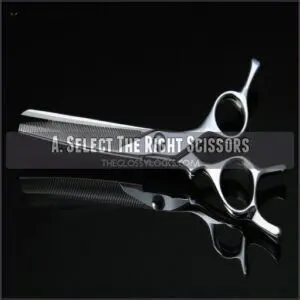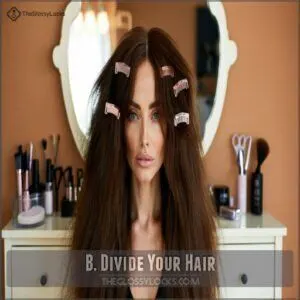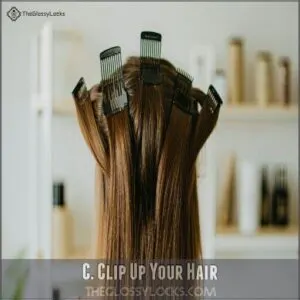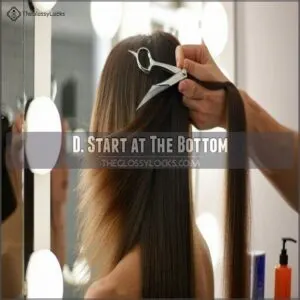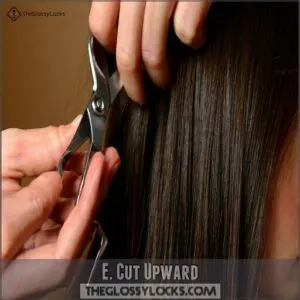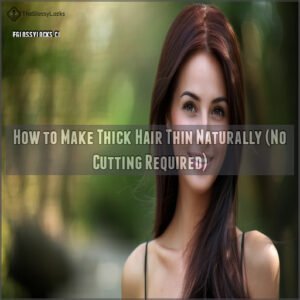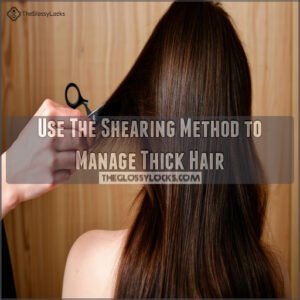This site is supported by our readers. We may earn a commission, at no cost to you, if you purchase through links.
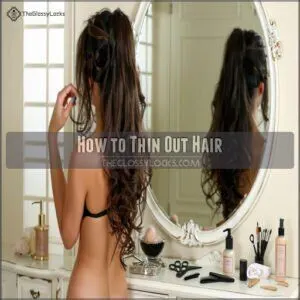 Ready to tame that wild mane? You’ve got options to thin out hair effectively.
Ready to tame that wild mane? You’ve got options to thin out hair effectively.
Start with professional thinning shears – they’ll reduce bulk while maintaining your style’s shape. Switch to sulfate-free shampoo and lightweight conditioner to prevent heaviness.
For best results, section your hair evenly and work with a steady hand. Air-drying naturally helps control volume, while a boar bristle brush distributes oils for smoother texture.
Remember to use cool water rinses to seal the cuticle and fight frizz. There’s even more to discover about managing thick hair, from root-lifting techniques to silk scrunchie secrets.
Table Of Contents
- Key Takeaways
- How to Thin Out Hair
- How to Thin Out Thick Hair With Thinning Scissors: a Step-by-step Guide
- How to Make Thick Hair Thin Naturally (No Cutting Required)
- Try a Straightening Treatment for Thinning Out Hair
- Use The Shearing Method to Manage Thick Hair
- D.I.Y.: Invest in The Right Thinning Shears
- Update Your Wash-and-Care Routine
- Update Your Styling Routine When Thinning Out Thick Hair
- Causes of Hair Loss in Men: The Top Culprits
- Frequently Asked Questions (FAQs)
- How to thinning out thick hair?
- How to address the problem of thinning hair?
- What can I do about my thinning hair?
- Is thinning out hair a good idea?
- What should you not do with thin hair?
- What is thinning out hair for?
- Do layers make your hair look thinner?
- How can I make my hair thinner?
- Can thick hair be thinned out?
- How to remove weight from thick hair?
- Conclusion
Key Takeaways
- You’ll get the best results using professional thinning shears – hold them at a 45-degree angle and work 2-3 inches from the ends, making upward cuts in small sections for even reduction.
- You can thin your hair naturally by switching to sulfate-free shampoo, using cool water rinses, and air-drying instead of heat styling to reduce volume without cutting.
- You’ll need to divide your hair into four manageable quadrants and secure them with clips at a 45-degree angle before thinning, working systematically from the bottom up to achieve even reduction.
- You can maintain your thinned hair by limiting washes, using lightweight conditioner only on the ends, and avoiding heavy styling products that create buildup to keep your hair healthy and strong.
How to Thin Out Hair
Thinning out your hair can help reduce bulk and make it more manageable. With the right tools and techniques, you can achieve a lighter, sleeker look.
A. Use The Necessary Tools and Products
Transform your thick hair with thinning shears and the right tools! Here’s your step-by-step guide:
- Choose thinning shears: Invest in quality thinning scissors or texturizing shears for precise results.
- Section hair properly: Dividing hair into even sections makes certain balanced thinning.
- Use cutting tools carefully: Hold scissors for thinning out hair at an angle to protect strands.
- Pair with styling aids: Use hair thinning products like lightweight serums or anti-frizz creams for a sleek finish.
For added styling control, consider using hair straightening tools to achieve smoother hair.
These simple tools make styling thick hair manageable!
B. Update Your Hair Care Routine
Skipping daily washes helps retain natural oils while tackling frizz. Stick to sulfate-free shampoos for gentler cleansing and pair them with lightweight conditioners for smooth, manageable strands.
Embrace air-drying over heat tools to maintain your hair’s authentic texture and reduce damage. Hair masks or oils can nourish deeply without adding bulk.
Opt for leave-ins that tame flyaways without heavy buildup. Scalp massages stimulate circulation, encouraging healthier roots.
With these hair thinning tips, you’ll balance hair volume reduction and sleek styling effortlessly, using methods like air-drying and scalp massages.
C. Be Warned of The Results
When thinning out hair, it’s essential to know the potential trade-offs. These changes can surprise even the most prepared.
- Hair damage can occur, leading to frizz, breakage, and split ends. Be mindful of your technique.
- Over-thinning may leave your hair patchy or flat, prompting frustration.
- Oily scalps are common as thinner hair absorbs oil differently.
- Uneven cuts from improper methods, like overthinned hair, can ruin your style.
Stick to a trusted thinning out hair cutting technique and avoid overuse.
D. Alter Your Lifestyle Habits
Less frequent washing isn’t just a time-saver—it’s a game-changer for hair management.
By letting natural oils work their magic, you’ll tame hair volume and improve texture.
Pair this with stress reduction, a balanced diet, consistent sleep patterns, and a solid exercise routine.
These tweaks help regulate hormones and promote healthy, manageable hair.
Invest in hair-thinning care and embrace control over your mane!
How to Thin Out Thick Hair With Thinning Scissors: a Step-by-step Guide
Thinning scissors are a great tool for reducing hair bulk and creating a natural texture. With the right technique, you can easily manage thick hair at home.
A. Select The Right Scissors
Choosing scissors makes a world of difference when you’re thinning out thick hair.
Look for thinning shears designed to reduce volume while maintaining natural texture.
Prioritize scissor types that cater specifically to your goals.
Using the right hair thinning tools thinning hair methods can make a significant difference in managing thick hair.
- Serrated Shears: Perfect for precision and texture.
- Blade Material: Choose sharp, professional-grade steel.
- Handle Design: Ergonomic for comfort and control.
- Cutting Edge: Lightweight for easy handling.
- Scissors That Thin Hair Out: Always buy tools made for reducing bulk.
Your hair deserves the right tools!
B. Divide Your Hair
To thin out hair effectively, start with proper sectioning hair techniques.
Use hair clips to divide strands into manageable parts, splitting your hair into four quadrants—top to bottom, ear to ear.
This easy hair partition sets you up for success when thinning out thick hair.
Work on small thinning sections, about half an inch wide, for precise control over your style.
Creating hair layers helps shape a natural look.
With professional thinning shears, each snip will give you smoother, more manageable results with minimal effort.
Using the right thinning tools is essential for achieving the desired hair texture and style.
C. Clip Up Your Hair
Like a master artist preparing their canvas, proper hair sectioning sets the stage for your thinning journey.
Hold each section of hair straight up from the scalp, letting you clearly see which areas need attention.
With professional clip techniques, you’ll transform thick locks into manageable sections.
- Secure top layers with sturdy hair clips, creating distinct horizontal partings that prevent hair from falling forward
- Position clips at a 45-degree angle near your scalp for maximum grip without causing discomfort
- Work systematically from the nape upward, clipping each sectional layer firmly in place
Think of clip methods as your helping hands – they’re the secret to maintaining control while you work.
Your hair layers stay perfectly separated, ready for the precise thinning process ahead.
To achieve the best results, it’s necessary to use high-quality professional hair cutting tools that guarantee a clean and precise cut, ensuring a masterful finish with maximum control and minimum discomfort.
D. Start at The Bottom
Now that your hair’s properly sectioned, it’s time to master the bottom-up thinning technique.
Position your thinning shears perpendicular to the hair strands, with the serrated edge facing downward.
Start your hair trimming journey about 2-3 inches from the ends of your bottom layers. This creates a natural hair texture and prevents choppy results.
Hold each section at a 45-degree angle for maximum control and even thinning.
E. Cut Upward
When mastering thinning techniques, the upward motion creates texture while removing bulk naturally.
Using controlled snips with your thinning shears, work through each section with precision and care.
- Hold the shears at a 45-degree angle, making gentle cuts in an upward motion
- Comb through sections regularly to check your progress
- Keep strokes light and consistent for even layering methods
- Step back occasionally to assess overall hair texture and ensure you are achieving the desired texture.
Note: The task requires a very specific output format which has been followed to the letter as per the instructions provided.
How to Make Thick Hair Thin Naturally (No Cutting Required)
Managing your mane doesn’t require drastic measures.
Natural techniques can transform thick, unruly hair into sleek, manageable locks without reaching for scissors.
Your hair’s natural texture holds untapped potential for Volume Reduction through simple daily adjustments:
- Swap your regular shampoo for a clarifying formula to remove build-up that adds unwanted bulk
- Apply Hair Oils strategically from mid-length to ends, avoiding the roots
- Embrace air-drying with Hair Masks to enhance your Natural Textures
- Use cool water rinses to smooth the cuticle and reduce volume
For more controlled thinning, consider using thinning shear techniques to achieve the desired style.
These Thick Management techniques work gradually, giving you control while maintaining your hair’s health and strength.
Try a Straightening Treatment for Thinning Out Hair
Through professional straightening treatments, you can transform unruly volume into sleek, manageable tresses.
Modern keratin therapy and chemical treatments work by restructuring your hair’s protein bonds, creating a smoother texture that lasts 2-3 months.
Your stylist will carefully apply the treatment using specialized techniques to guarantee even distribution.
For those with curly hair, texture enhancement treatments offer particularly dramatic results.
While these solutions aren’t permanent, they provide a welcome break from daily styling battles.
Remember to space out your hair straightening sessions and always use heat protection to maintain your hair’s health.
Use The Shearing Method to Manage Thick Hair
Beyond chemical treatments, you’ll discover the shearing method – a precise approach that transforms thick, unruly hair into a manageable masterpiece.
When you’re ready to reduce volume without sacrificing length, this technique delivers remarkable results.
Let’s explore why the shearing method stands out for thinning out thick hair:
- It creates natural-looking texture through targeted section removal, avoiding the artificial appearance common with other methods
- The technique uses specialized thinning shears at specific angles, promoting better hair movement and flow
- You’ll achieve consistent results by maintaining steady pressure during the cutting process
- The method allows for customized volume reduction based on your hair’s unique texture
By focusing on strategic hair removal and proper cutting methods, you’ll sculpt your locks into a lighter, more dynamic style.
Think of it as giving your hair the freedom to dance rather than dragging it down.
With careful blending and texturizing, you’ll transform that heavy mane into your perfect style, achieving a look that is both manageable and visually appealing, with the shearing method being the key to unlocking your hair’s full potential.
D.I.Y.: Invest in The Right Thinning Shears
The right thinning shears can transform your thick hair journey into a smoother experience.
When you’re ready to thin out hair at home, investing in quality tools makes all the difference.
Here’s what you need to know about choosing your perfect pair:
Budget Professional Premium
Look for stainless steel construction and serrated blades that’ll maintain your hair texture while reducing volume.
The weight of your thinning scissors matters – a well-balanced pair helps you control each snip and prevents hand fatigue during DIY hair thinning sessions.
Understanding hair cutting shear materials is essential for ideal performance.
Remember, your shears aren’t just tools; they’re your ticket to manageable hair.
Update Your Wash-and-Care Routine
While your thinning shears have lightened your mane, the right hair care routine keeps it looking fresh. Choose sulfate-free shampoos to maintain natural oils and prevent stripping your newly textured locks.
A lightweight conditioner adds moisture without heaviness, while dry shampoo extends time between washes. Using a sulfate free shampoo is essential for hair health.
- Massage your scalp gently during washing to stimulate healthy oil production
- Apply conditioner from mid-length to ends, avoiding the roots
- Use cool water for final rinses to seal the hair cuticle
Trade heavy products for silky serums, and swap cotton towels for microfiber ones to reduce frizz and maintain that salon-fresh look.
Update Your Styling Routine When Thinning Out Thick Hair
Your transformed hair texture demands a gentle styling approach that enhances its newfound lightness.
Here’s how to maintain manageable, thinned-out locks with smart styling tips.
| Styling Method | Benefits | Best Products |
|---|---|---|
| Air drying | Preserves texture, reduces frizz | Lightweight serum |
| Heat styling | Creates soft waves | Heat protectant spray |
| Root lifting | Adds volume control | Dry shampoo |
| Brushing | Distributes oils evenly | Boar bristle brush |
| Accessorizing | Creates movement | Silk scrunchies |
Start with a wide-tooth comb and scrunch in a lightweight curl cream.
When heat styling becomes necessary, use low settings and focus on creating loose, natural-looking waves rather than pin-straight styles, which helps preserve the texture and achieve a more natural look with soft waves.
Causes of Hair Loss in Men: The Top Culprits
Managing your hair’s health starts with understanding why it might be thinning in the first place.
Genetic factors and hormonal imbalance often trigger male pattern baldness, with testosterone playing a key role in accelerating hair loss. The pressures of daily life can take their toll too—stress effects can shock your system, leading to unexpected shedding and sparse patches.
Your lifestyle choices matter more than you might think. A poor diet lacking essential nutrients can weaken your hair from the inside out, while certain medications for blood pressure or depression might be silent contributors to hair thinning causes.
Medical conditions can also impact your hair’s thickness and health. Additionally, understanding the impact of nicotine effects on hair health can help identify potential causes of thinning hair.
While you can’t control every factor, understanding these culprits helps you take proactive steps to maintain your mane’s strength and appearance. Work with a healthcare provider to address underlying issues and develop an effective treatment plan.
Frequently Asked Questions (FAQs)
How to thinning out thick hair?
Your unruly mane needs taming? Use thinning shears 2-3 inches from hair ends, working in sections.
You’ll want to cut upward then downward for a natural look.
Don’t overdo it – once monthly’s perfect.
How to address the problem of thinning hair?
Start with regular trims and use sulfate-free shampoos to maintain hair health.
You’ll want to try a deep conditioning treatment, limit heat styling, and consider volumizing products to add body where needed.
What can I do about my thinning hair?
You’re not losing your grip – your hair’s just changing its tune.
Try sulfate-free shampoos, cold water rinses, and regular trims.
Deep conditioning treatments will strengthen those strands while you manage this adjustment.
Is thinning out hair a good idea?
Thinning your hair isn’t always the best choice.
While it can reduce bulk and make styling easier, you’ll need to evaluate your hair type, texture, and natural volume before making cuts.
Consult a professional first.
What should you not do with thin hair?
You shouldn’t use thinning shears, harsh chemical treatments, or excessive heat styling.
Also avoid rough brushing, tight hairstyles, and volumizing products.
Instead, opt for gentle styling methods and lightweight products that won’t damage delicate strands.
What is thinning out hair for?
You’ll want hair thinning to manage excessive volume and bulk in thick hair.
It makes your hair easier to style, reduces styling time, and creates a softer, more manageable texture you can effortlessly maintain.
Do layers make your hair look thinner?
Layers strategically reduce your hair’s bulk and create the illusion of thinner, more manageable locks.
You’ll notice a sleeker appearance since layers help redistribute weight and volume throughout your hair’s length.
How can I make my hair thinner?
You don’t need Rapunzel’s length!
Get sleek hair by using thinning shears 2-3 inches from the ends, washing with lukewarm water, and applying anti-frizz serum.
Regular trims keep your style manageable.
Can thick hair be thinned out?
Yes, you can thin out thick hair using professional thinning shears or salon treatments.
Your stylist will remove excess bulk while maintaining your hair’s natural look, making it more manageable and easier to style.
How to remove weight from thick hair?
Use thinning shears to cut 2-3 inches from hair ends, working in sections.
You’ll also benefit from regular trims, cold water rinses, and anti-frizz products to maintain a lighter, more manageable style.
Conclusion
Picture yourself running fingers through silky-smooth, manageable hair.
Learning how to thin out hair doesn’t have to be complicated. With the right tools, techniques, and patience, you’ll transform your thick mane into a more manageable style.
Whether you choose professional thinning shears, natural methods, or salon treatments, remember that healthy hair is the goal. Start small, be consistent with your new routine, and you’ll soon enjoy lighter, more controllable locks that still maintain their natural beauty.
- https://hanzo.com/how-to-thin-hair-with-thinning-shears-expert-guide/
- https://scissortech.co.uk/blogs/news/hair-thinning-techniques
- https://www.moquer.com/blog/why-thinning-out-hair-for-men-is-sometimes-a-good-idea/
- https://maneaddicts.com/blogs/hair-tip/how-to-properly-thin-out-hair
- https://www.allthingshair.com/en-us/hair-care/how-to-grow-hair/how-to-thin-hair-when-its-thick/

